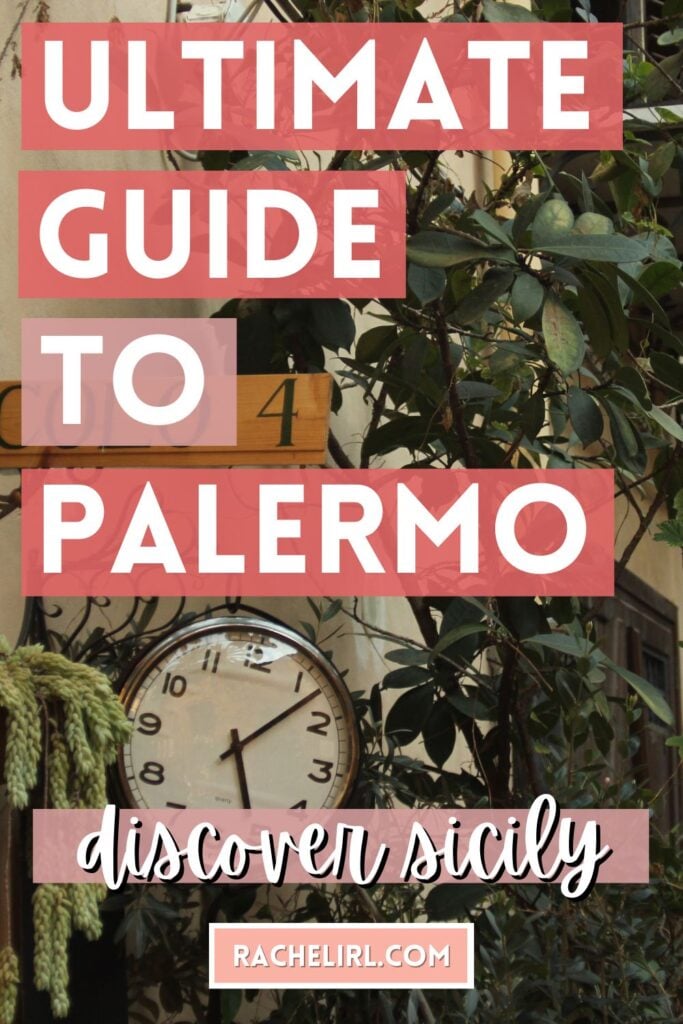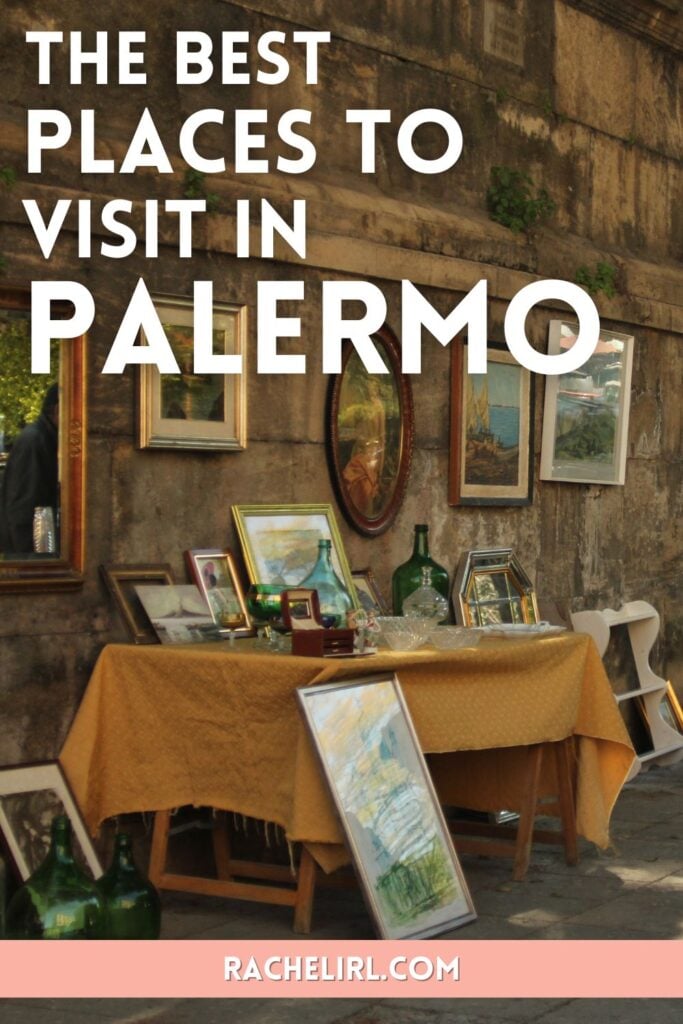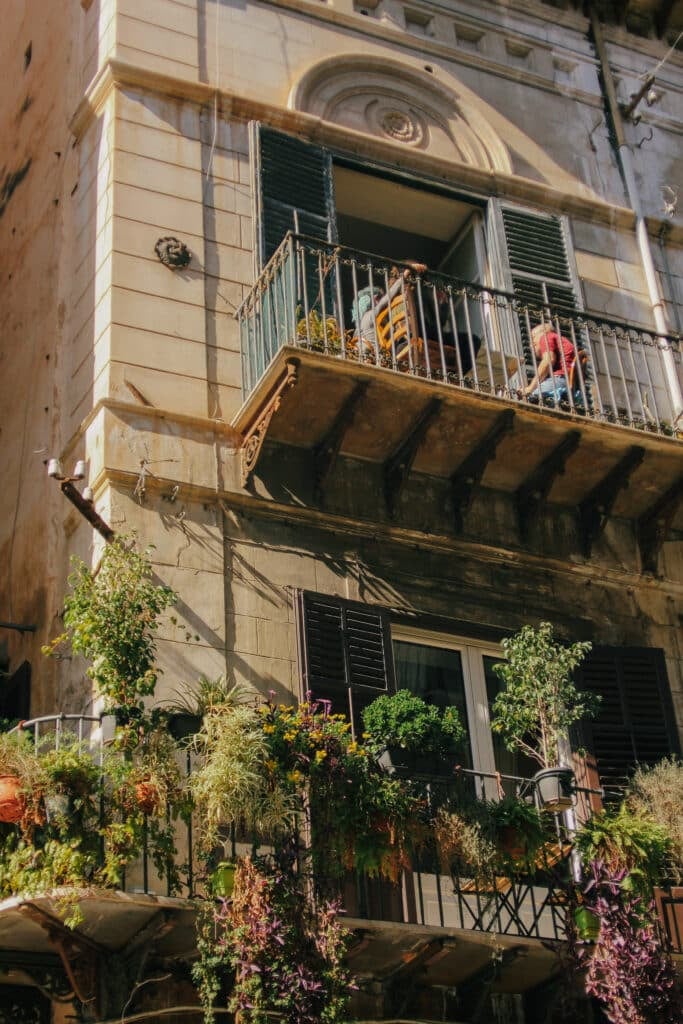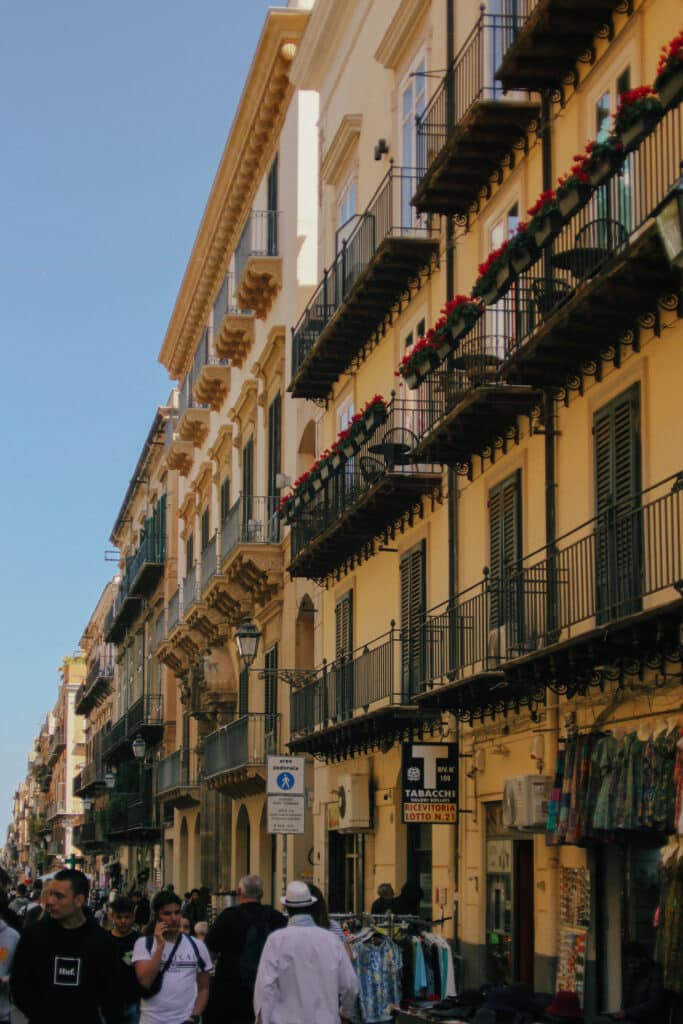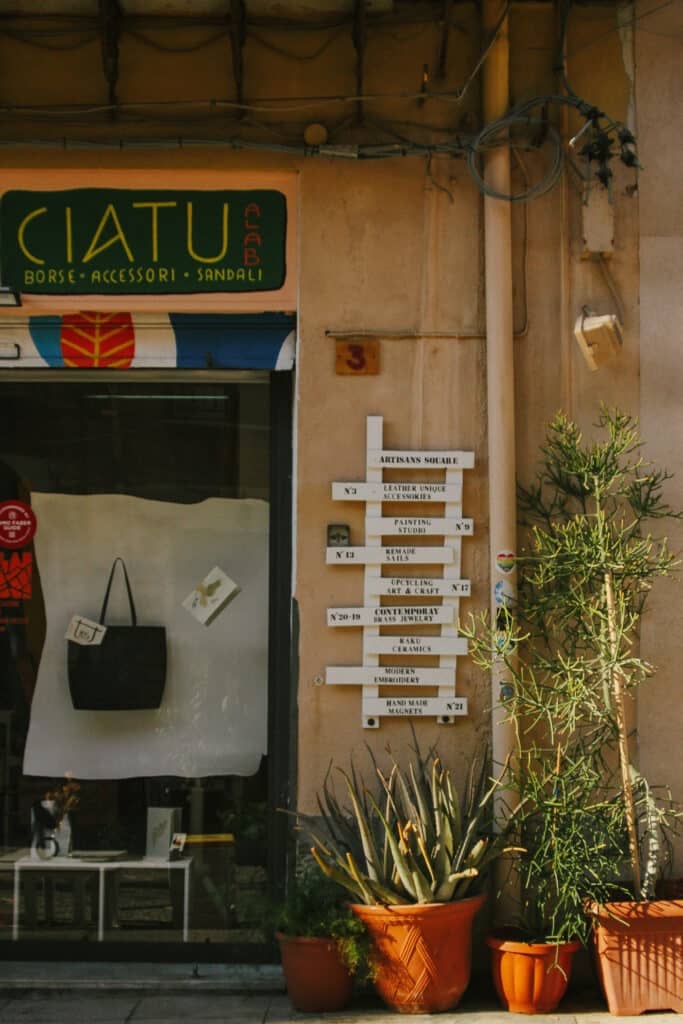Just a heads up: Some of the links on this page are affiliate links, meaning I may earn a commission if you book through them (at no extra cost to you). Your support helps me keep Rachel IRL going, so thank you! To read more, please see my affiliate disclosure.
When we arrived in Palermo — during the second half of my second trip to Sicily — I didn’t know what to expect, if I’m honest. I’d spent a decent amount of time searching for things to do in Palermo, and like you (I’m assuming), was scouring all the blog posts trying to craft the perfect few days.
But despite all my research, I was nervous! I’d only previously spent time on the east side of Sicily, and if you’ve read my other Sicily posts, you’ll know I’m fully enamored with the beauty and energy of the east coast. I worried that, like so many capital cities, Palermo would feel a bit overrun with tourism—perhaps a bit inaccessible in any sort of authentic way. I visited in late March, so there was no chance of a beach escape if I hated it.
But I like a challenge, and so I approached Palermo determined to find something to like.
Lucky for me, my fears were founded on literally nothing. What’s that cheesy John Green quote? Falling in love is like falling asleep: slowly, and then all at once (I’m sure I’ve butchered that — sorry, John). That was me with Palermo.
It snuck up on me, and I tried to resist it, but I swear to god by the second day I was trying to convince Daniel we should move there. So I think it’s safe to say I liked it. It’s messy and magical in equal measure — a city of grand baroque facades, open-air chaos, crumbling beauty, and some of the best street food I’ve had anywhere.
Ultimately, I think Palermo is a city to be experienced. So while I’ll do my best in this post to convey the energy you’ll find and detail all the best things to do in Palermo, just know that this doesn’t hold a candle to the real thing.
This Palermo guide includes everything I loved — from cultural landmarks and market bites to late-night piazzas and vintage shops. I’ll also share where to eat, what to skip, and how to explore the city like a local. Whether you’re visiting for a weekend or a week, Palermo is 100% worth your time.
- 13 Best Things to Do in Palermo, Sicily
- 1. Palermo’s Iconic Street Markets
- 2. Quattro Canti, Palermo’s Beating Heart
- 3. Via Vittorio Emanuele
- 4. Palermo’s Historic Core: Cathedral, Palace & More
- 5. Kalsa Neighborhood
- 6. Kalsa’s Sunday Antique Market
- 7. Palermo’s Vintage Shops
- 8. Museums, from Mafia to Majolica
- 9. Off-the-Beaten-Track Looks at Palermo
- 10. Escape the Heat at Mondello Beach
- 11. Sunset Views from Mount Pellegrino
- 12. Capuchin Catacombs
- 13. Day Trip to the Ancient Temple of Segesta
- Where to Eat in Palermo
- Where to Stay in Palermo
- FAQs about Things to do in Palermo
Dreaming about a Palermo getaway?
Here’s a mini guide to help you plan a perfect stay!
Where to stay:
Things to do:
How to get around:
Stay connected:
More on Sicily:

Delve into Sicily
Don’t forget to check out the rest of my Sicily posts and guides if you’re still planning your perfect trip!
13 Best Things to Do in Palermo, Sicily
Real Talk:
Sicily—like so many parts of Italy—is feeling the pressure of overtourism. And while I want to believe that if you’re here on my blog, you’re the kind of traveler who cares about leaving places better than you found them… I still have to say it:
Don’t be an asshole when you travel. Not in Sicily, not in Italy, not anywhere.
I’ve seen too many visitors treat locals like background characters or behave like the region exists solely for their vacation. So here’s your friendly-but-firm reminder:
If you’re going to make people’s lives harder, please just stay home.
1. Snack Like a Local at Palermo’s Iconic Street Markets

Palermo is world-famous for its street food — and for good reason. Arancine (fried rice balls), sfincione (pillowy, tomato-topped bread), and panelle (chickpea fritters) are just the beginning. The best way to try them: wander the markets the way locals do… casually, hungrily, and with zero plan.
There are three major historic markets in Palermo: Ballarò, Vucciria, and Capo — each one tied to a different neighborhood in the old city, and each offering its own kind of chaos. You’ll get differing opinions about which one is the best depending on who you ask, so I recommend checking out all three to see for yourself!
These markets a great way to get a taste for Sicilian daily life, and to see some of the Arab influences left over in the city. A lot of advice warned us that we’d feel overwhelmed while visiting the Palermo markets, but personally I think that the markets all felt exactly like the souks that we’ve been to in the Middle East and North Africa, or similar markets in Asia and Southern Africa. Basically, if you’ve been to any non-Western market, then the vibe will feel familiar: a little loud and messy, yes, but also totally alive. That being said, if you haven’t had experience in that type of environment, it will definitely be a shock to the system (but not a bad one)!
Expect ordered chaos, people yelling in every direction, and more sights and smells than you can imagine.

Insider Tip
This is true for every market you visit to be honest: wear closed-toed shoes if you can. It’s not the end of the world if you don’t, but trust me, you only have to step in mystery liquid while surrounded by dead fish and butchered meats once before you think twice about wearing sandals to a market again.

Ballarò Market: The Wildest and Most Local
Ballarò is the biggest, oldest, and most intense of the Palermo markets. It also happens to be the most “authentic” of the three. Located in the Albergheria district, it has an undeniable rough-around-the-edges energy. It’s where you’ll find locals shouting over vegetables, kids weaving through alleyways, and stalls that sell everything from fish to phone cases. The Ballarò market is also unique because it sits in a less touristy part of the old town that you might not have normally gotten to see, making it feel off the beaten track in the best sort of way.
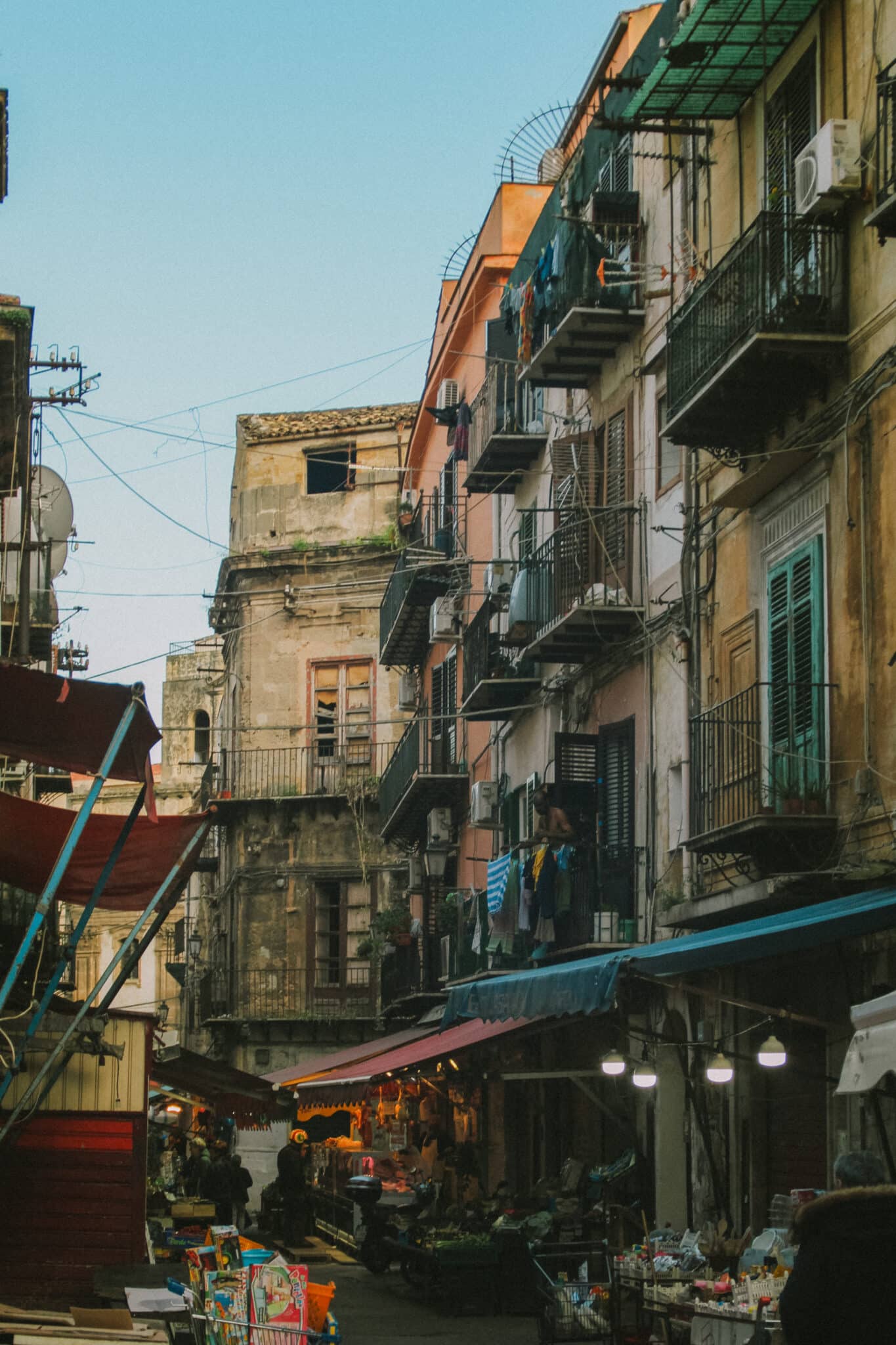
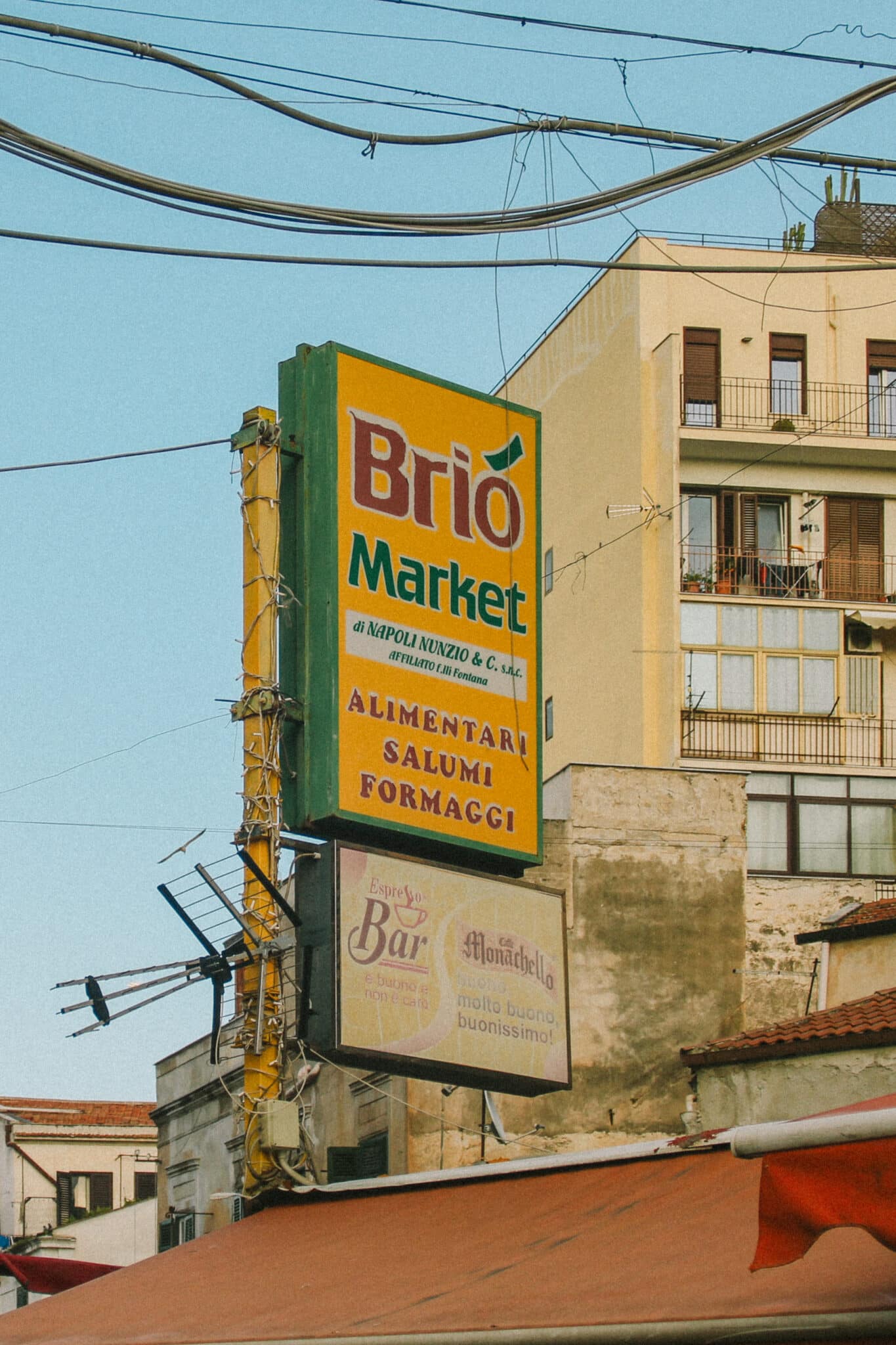
Snack Your Way Through Palermo
Street food is the way to get under Palermo’s skin. From arancine and panelle to sfincione and a cheeky cannolo to finish, this street food-centric walking tour takes you through Capo Market and past the city’s icons, with bites as unforgettable as the views.
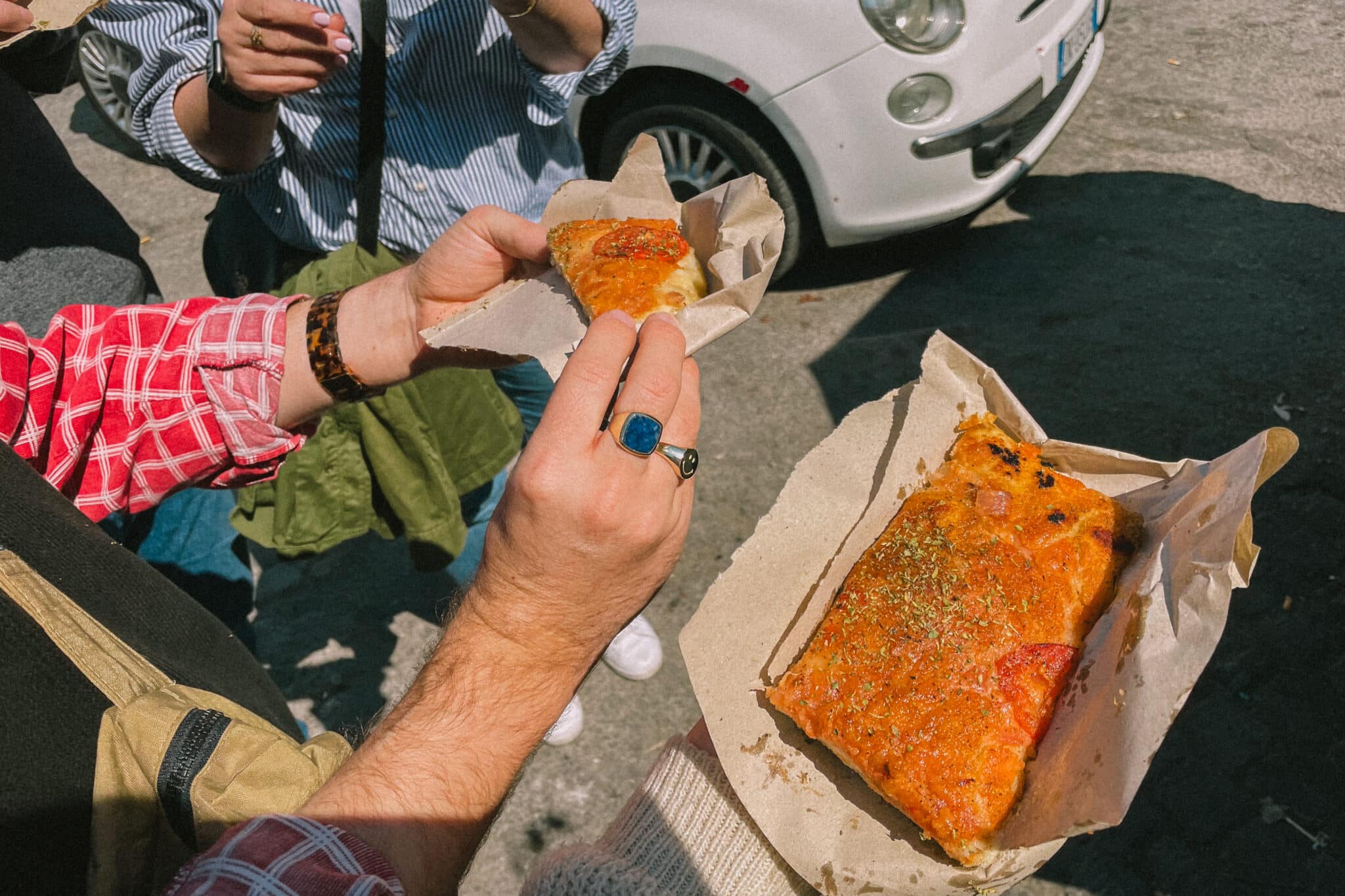
Vucciria Market: Quiet by Day, Party by Night
Vucciria is the market that we were staying the closest to, so we passed through it a number of times. Vucciria, in my opinion, is best visited in the evening for a drink or late afternoon snack.
It felt pretty quiet by day, and we honestly wondered if there just wasn’t much to the market, at least not that we could find, but at night it completely transforms and comes alive. There are little bars that line the streets where you can get an aperitivo, and further into the chaos you’ll find a wide open square, Piazza Caracciolo, with music, food stalls and people drinking all over the place. It’s your classic golden hour, European summer open air drinking vibes (if you know, you know).

Insider Tip
I wouldn’t recommend eating dinner here—it’s very tourist-forward—but it’s perfect for a pre-dinner aperitivo.
Capo Market: Best for Street Food Sampling
Capo was my favorite market in Palermo for actually eating. It’s more organized than Ballarò, and has plenty of food stands and small sit-down spots that don’t feel touristy like Vucciria’s. We explored it on a food and history walking tour and got to try nearly every iconic street food Palermo’s known for.


Insider Tip
Capo is right by Teatro Massimo and the old city walls, so it’s a convenient pairing when making your itinerary!
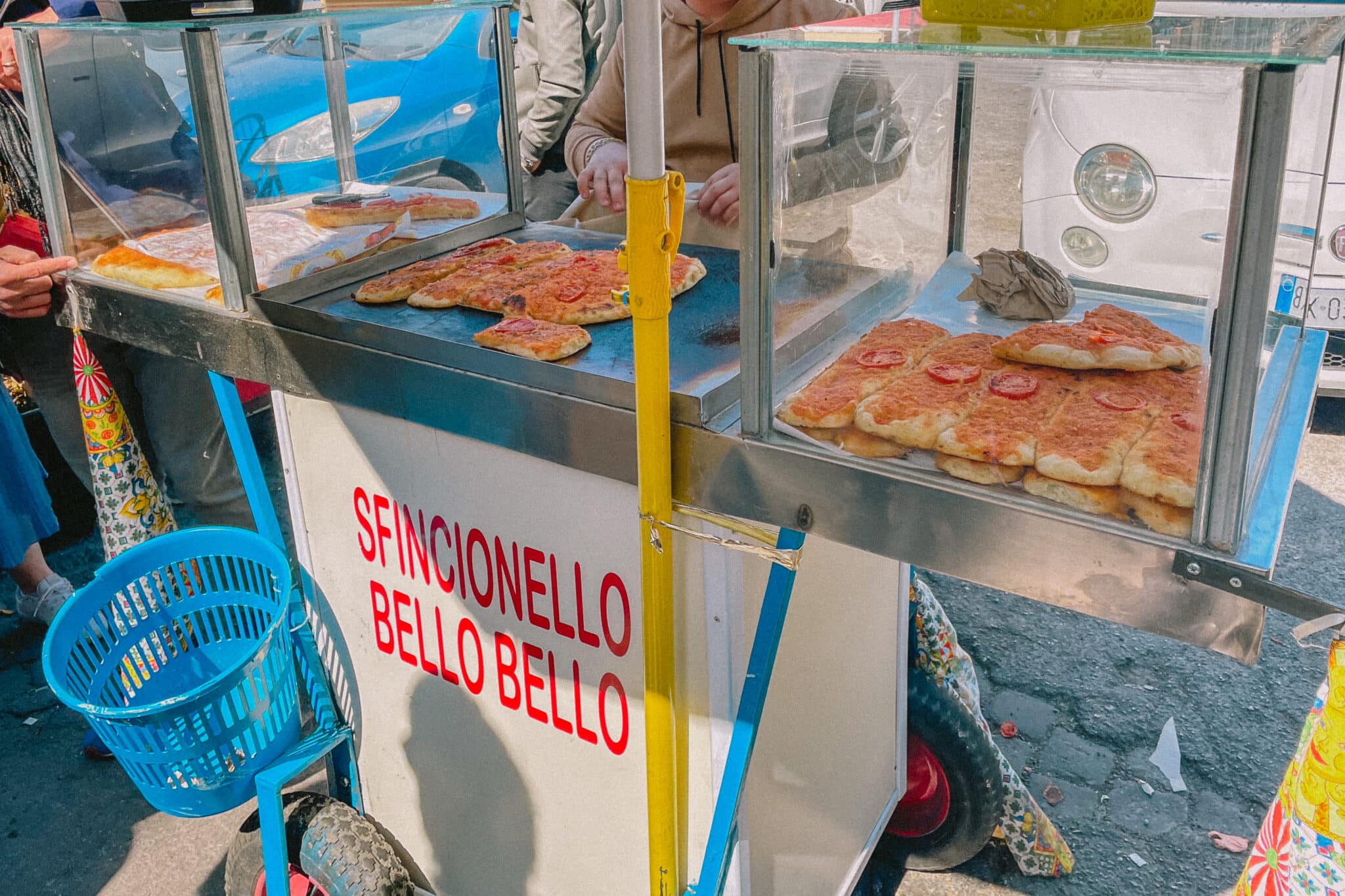

Planning Cheat Sheet: Every Link You Need in One Place
P.S. When you book using my links, you help support Rachel IRL at no extra cost to you. It’s a win-win!

2. Admire Quattro Canti, Palermo’s Beating Heart
If Palermo has a beating heart, Quattro Canti is it. This dramatic, four-cornered square marks the center of the old city and connects Palermo’s two major roads: Via Maqueda and Via Vittorio Emanuele. It’s also the spot where all four main historic neighborhoods — Albergheria, Capo, Kalsa, and Vucciria — meet.
The square itself is made up of four curved facades, each decorated with statues representing the seasons, Spanish kings, and Palermo’s patron saints. It’s dramatic and symmetrical in that classic baroque way — and it’s likely you’ll pass through it a lot during your time here, so if you find yourself wanting more context, I recommend a walking tour!

Insider Tip
The area is technically pedestrianized, but Palermo drivers operate on vibes, not rules — so still keep an eye out for rogue vehicles. Also, be prepared for hawkers trying to sell you horse rides, snow cones, and all manner of wildly overpriced trinkets.
Each quadrant of Quattro Canti is one of the four main neighborhoods of Palermo: Albergheria, Capo/Monte di Pietà, Kalsa and Vucciria/Castellammare. When you’re facing south, you’ll get a perfectly framed view of the mountains in the distance, which honestly makes it worth visiting on its own.
Dive Into Palermo’s Dark Legends
If the usual three-hour history dump walking tours aren’t your thing (relatable!!), this tour is a game-changer. It zooms in on Palermo’s mysterious Beati Paoli – think, a medieval Robin Hood-like society focused on attacking the wealthy on behalf of the poor – and their underground world. The blending of legend, secret passages, and just the right amount of drama will keep you hooked start to finish!
3. Wander Via Vittorio Emanuele for Hidden Gems and Views
One of the oldest streets in Palermo, Via Vittorio Emanuele runs all the way from the sea to the Porta Nuova — the historic city gate that once marked the boundary between old and new Palermo. But the best stretch is the pedestrian-friendly section between the Palermo Cathedral and Giardino Garibaldi, near Kalsa.
Along this street you’ll access many of the best things to do in Palermo, but you’ll also find all kinds of little shops and vendors for you to explore and peruse. I found some adorable prints for my kitchen, as well as some handmade jewelry while walking along the street. This street is also home to the No Mafia memorial and the Palermo Cathedral (more on those later).
Is it a little touristy? Sure. But there’s still plenty of character — especially if you keep your eyes open and don’t stick to the main drag too tightly.
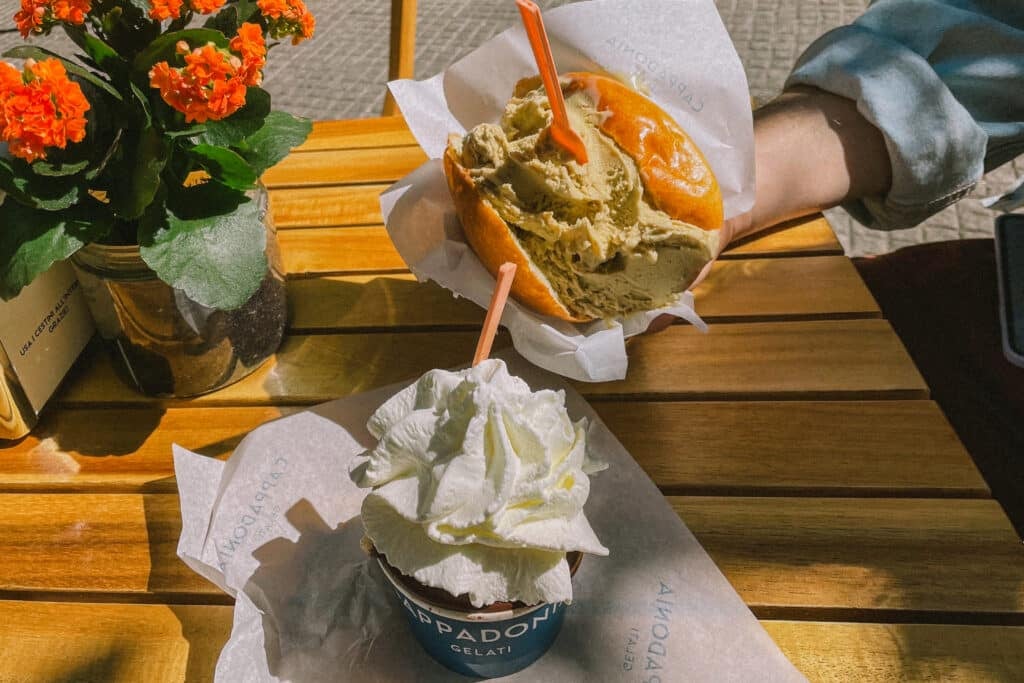
Skip the restaurants here (most are overpriced and forgettable), but if you need to revive yourself, grab a scoop from Cappadonia Gelati – it’s the real deal.
4. Explore Palermo’s Historic Core: Cathedral, Palace & More
This cluster of landmarks is all within easy walking distance, so if you’re short on time, you can knock out several of the best things to do in Palermo in a single loop (with plenty of time for snacks in between).
Palermo Cathedral

The Cathedral of Palermo is, in my opinion, the crown jewel of Via Vittorio Emanuele. It’s without a doubt one of the city’s most iconic structures, and maybe the best visual example of Sicily’s varied history. From the outside, it’s an imposing blend of Arab-Norman-Gothic styles, with spires, domes, and intricate carvings that remind me a lot of some of the architecture you’ll see in Spain.

Did You Know
Don’t let your eyes glaze over at the mention of Arab-Norman-Gothic architecture!! Even if you’re not a history buff, oen of the coolest things about Palermo is just how layered its history is… we learned our our tour that it is among the most conquered cities in history, anywhere in the world. And the constant changing of hands shows up perfectly in the Palermo Cathedral.
Inside, the cathedral is a bit less unique, but still definitely worth a peek, especially for the zodiac calendar inlaid in the floor near the front (I love an astrology moment). If you’re up for a stair climb, you can gain combined access the roof and an audioguide of the building for €14. I didn’t get a chance to take in this panoramic view of the city, but tbh wish I had!
Norman Palace & Palatine Chapel

The Palazzo dei Normanni, or The Norman Palace, is a palace dating back to the 9th century and is home to Sicily’s regional parliament.
The palace, along with the famous Royal Palace and Palatine Chapel that sits behind it are famous for their unbelievable mosaics and paintings that mix Byzantine, Islamic, and Romanesque styles..
Honestly, it’s jaw-droppingly beautiful and worth budgeting time for.
Step Inside Palermo’s Crown Jewel
The Norman Palace and its Palatine Chapel are the city’s show-stoppers—gold mosaics glittering overhead, every inch layered with stories of kings and conquerors. A guide brings it all to life in under two hours, so you’ll leave with more than just pretty pictures.
And while I’ll admit I usually find the early Middle Ages boring af, Daniel just finished The Invention of Sicily and swears the Sicilian Normans were a surprisingly fascinating dynasty—championing cosmopolitan multiculturalism and building one of the most advanced, diverse societies of their era.
Porta Nuova
Porta Nuova is, as we’ve covered, the historic gate to the city, and marks the end of Via Vittorio Emanuele, separating the old and new parts of Palermo.
It’s an absolutely stunning structure dating back to the 1500s, although the conical top bit was rebuilt in the 1600s after it was destroyed in a storm.
It’s a beautiful and ornate monument to the city’s history!
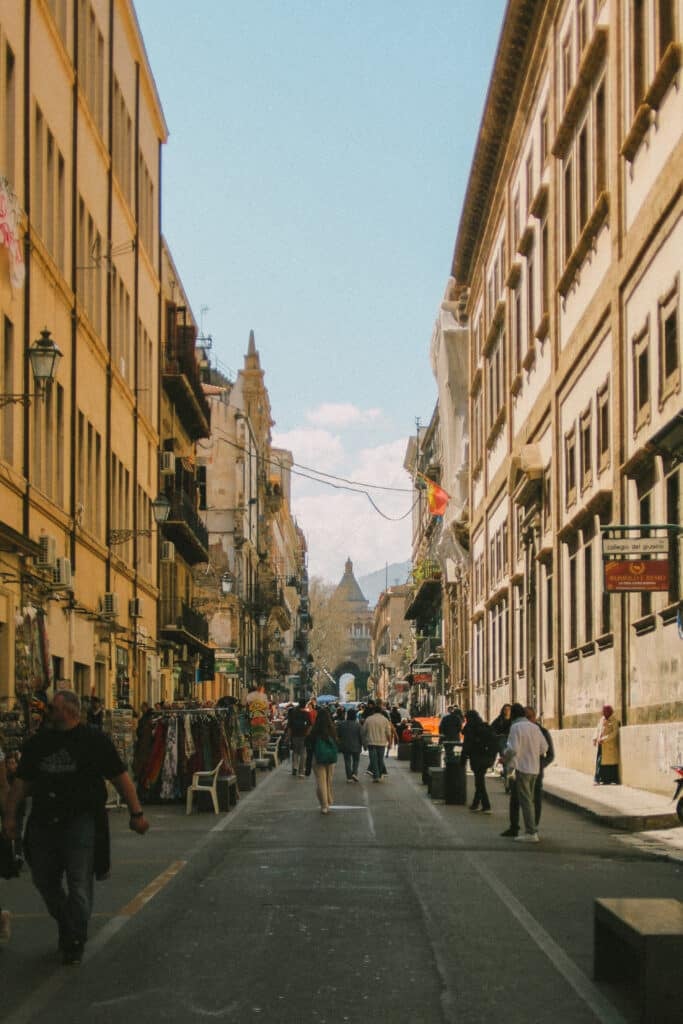
Villa Bonanno
And last but not least is Villa Bonanno, a leafy public park that sits just in front of the Norman Palace and offers a perfect spot to sit, snack, or decompress after sightseeing. It’s not a destination in itself, but if you need a shady bench and a bit of calm before your after your tour, this is your place.

5. Wander the Kalsa Neighborhood Like a Local
Kalsa is one of the four main districts in Palermo’s old city — but it still flies slightly under the radar, especially compared to more on-the-beaten-track neighborhoods like Capo or Vucciria. That makes it the perfect place to slow down, sip something cold, and follow your curiosity down quiet side streets.
Kalsa is full of the contradictions that always seem to accompany a gentrifying neighborhood—trendy and worn-down, artsy and chaotic, local and up-and-coming all at once. You’ll find street art next to centuries-old churches, and minimalist cafes tucked between crumbling facades.

Know Before You Go
It’s impossible to talk about Kalsa without acknowledging the effections of ongoing gentrification in the area. Many of the cute spots we love to visit often come at the cost of pricing out longtime locals. There are no perfect answers, but I try to be mindful — for example, by avoiding short-term vacation rentals in this part of the city, and supporting small, local businesses instead.
I do think that a good rule of thumb would probably be trying not to rent Airbnbs in this area, as Airbnb has been detrimental to so many cities undergoing gentrification. So just keep that in mind and be mindful of the situation.
If you turn off of Via Vittorio Emanuele onto Via Alessandro Paternostro you’ll come across countless small artisan shops, restaurants and bars. There’s actually an artists’ collective in the area, and you can locate participating shops by the orange window stickers they all display.
Evenings in Kalsa feel like a block party. Locals gather outside bars, sitting on curbs and balancing Aperol spritzes on ledges. It’s informal, friendly, and one of the best ways to feel like you’re part of the neighborhood rather than just passing through.

If you keep following Via Paternostro into the neighborhood you’ll reach Piazza Aragona, a small square with many more cafes and bars, as well as more cute shops—this area is another great option for evening drinks. From there you can continue left down Via Alloro or straight through towards Piazza Rivoluzione. Like most areas in Palermo, it’s best to be discovered through curiosity and wandering, so don’t feel the need to take these instructions literally… just explore!
Not trying to leave your good time up to chance?
Skip the guesswork. I’ve pinned all my favorite bars, cafes, and little shops in Kalsa (and beyond) into a custom Google Maps layer.
Load it straight into your app and you’ll have my Palermo picks in your pocket while you explore.
Landmarks & History to Explore:
Kalsa is also deeply connected to Palermo’s anti-mafia history — it’s the childhood home of judges Paolo Borsellino and Giovanni Falcone, who were assassinated for their work against organized crime. You can visit key sites with the No Mafia walking tour, or simply pass Borsellino’s former home on Via della Vetriera.
Piazza Pretoria Fountain (aka the Fountain of Shame) is a baroque showstopper located just off Quattro Canti. Golden hour is especially beautiful here.

Santa Maria dell’Ammiraglio (also called La Martorana) is nearby and houses the most stunning Byzantine mosaics I’ve ever seen.
Get to Know Palermo Beyond the Godfather Myths
Forget the film clichés—the No Mafia walk is about real people who stood up to the Mafia and reshaped Palermo in the process. You’ll pass street markets, landmarks, and shopfronts marked with the Addiopizzo sticker (proof the owners refuse to pay protection money). Heavy history, yes—but told in a way that will undoubtedly deepen your experience in Palermo.
6. Treasure Hunt at Kalsa’s Sunday Antique Market

This one seriously deserves an entire point to itself!
On our last day in Palermo, I had a few hours to myself — and I did what I always do when I’ve got solo time in a new city: wander. That’s how I accidentally stumbled into what turned out to be one of my favorite Palermo experiences.
I didn’t see this listed in English anywhere online, so I’m really glad I found myself stuck in the middle of it.
Every Sunday morning, the area around Giardino Garibaldi transforms into an absolutely massive antique market — and I genuinely can’t believe I hadn’t read about it anywhere beforehand. It’s packed with vintage clothes, secondhand books, furniture, cameras, jewelry, and so much random treasure I couldn’t even begin to list it all.

The crowd felt entirely local — in fact, I was probably the only tourist there on a random Sunday in March. Most vendors spoke only Italian (or just enough English to complete a sale), but as usual in Sicily, everyone was warm and patient, even with my half-charades communication style.
At the market you’ll find a mix of all kinds of things: old books, vintage clothes, antique furniture and knick knacks, records, film cameras, jewelry, literally anything. After exploring for over an hour I think I’d only covered about half of it. I managed to get myself a pretty nice (working) point-and-shoot film camera for €25, and two old books which is a total win for me.

Insider Tip
Bring cash! A few vendors took cards, but most didn’t — and the nearest ATM charged a fortune in fees.
If you’re in town on a Sunday, I highly recommend carving out a couple of hours for this. Even if you don’t buy anything, it’s an amazing glimpse into real, everyday Palermo — quirky, friendly, and completely untouristed.
7. Thrift Stylish Souvenirs at Palermo’s Vintage Shops

One of my favorite things to do while traveling—especially in cities that aren’t overly polished—is to go vintage shopping.
It’s a great way to find souvenirs that are actually wearable and meaningful, and it always gives me a feel for the city’s real style.
Palermo is no exception.
The vintage scene here is small but special, and full of one-of-a-kind finds. Here are a few of the best spots I visited:
None of these places are especially touristy or overpriced, which is part of why I loved them. If you’ve got space in your bag (or don’t mind wearing what you buy right away), these shops are a great way to experience a different side of Palermo.
8. Dig into Palermo’s Museums — From Mafia to Majolica
If you’re the type of traveler who likes to understand a city’s deeper layers, Palermo’s museums are absolutely worth your time. You’ll find everything from ancient ruins to anti-mafia activism to Sicilian tilework — and they all help explain what makes this city so complex and unforgettable.

No Mafia Memorial
This one is essential. The No Mafia Memorial is free to visit, but its impact is huge — it walks you through the history of mafia power in Sicily and the grassroots resistance that continues today. It’s detailed, often intense, and incredibly moving. It’s a pretty graphic museum, so do take that into account.

Insider Tip
If you can, pair this with the No Mafia tour run by Addiopizzo. The tour brings the context alive through real locations and lived experience — I wish I’d done the tour first, then visited the museum after.
Palermo Archeological Museum
The Palermo Archeology Museum one flies under the radar, but if you’re into ancient history, you’ll love it. The collection includes artifacts from Carthaginian, Greek, and Roman Sicily: all the stuff that helps explain how this island ended up with such a mix of influences.
Majolica Museum
Located in Kalsa, The Majolica Museum is a small but stunning museum showcasing over 5,000 Sicilian ceramic tiles, arranged by color and era. It’s housed in a palazzo apartment and feels more like stepping into someone’s beautifully obsessive collection than a typical museum — in the best way.
Museo RISO
When you need a break from ruins and religious art, head here. Museo RISO features modern works by Sicilian artists from the 1950s to today. It’s inside a baroque palazzo on Via Vittorio Emanuele and also has a cute café tucked in the courtyard if you need a reset.
Puppet Museum

Quirky but culturally rich, the Puppet Museum celebrates Sicily’s unique puppetry tradition — complete with historic marionettes and live shows. It’s fun, offbeat, and makes a great stop if you’re traveling with kids (or just like weird little museums, like me).
9. See Every Side of Palermo: From Backstreets to the Sea
If you’re the kind of traveler who wants to go deeper than just checking off monuments, Palermo has some wildly creative guided tours that show you the city through different lenses — whether you’re into food, art, history, or just want to ride in a vintage car.
These aren’t your average walking tours — they’re personal, often run by locals, and give you a totally different point of view.
Palermo in a Vintage Fiat 500
Yes, it’s as fun as it sounds. This tour takes you through the historic center and out toward Mondello Beach — all in a colorful retro car. It’s perfect if you want to cover more ground without sacrificing vibes.
Art & Architecture Tour
This one’s for the design nerds (me). Palermo’s buildings reflect centuries of conquest and co-existence — Arab, Norman, Baroque, and more — and this tour breaks it all down while you wander through the city’s most jaw-dropping facades.
Baroque & Aristocracy Tour
Focused on Palermo’s nobility and lavish past, this tour goes deep into the city’s aristocratic history — the families, the palaces, the scandals. If you love juicy historical context and slightly crumbling grandeur (especially if you’ve read or watched Lampedusa’s The Leopard) this one’s for you.
Sailing Trip to Mondello
Swap the cobblestones for the sea and spend a day sailing along the coast. These small group tours leave from Palermo’s harbor and include swimming stops, Sicilian snacks, and views of Mondello from the water.
10. Escape the Heat at Mondello Beach

Palermo doesn’t technically have its own beach, but Mondello — just 30 minutes outside the city — more than makes up for it. This former fishing village is now a full-on beach town with crystal-clear water, sandy shores, and a lively (sometimes very lively) summer crowd.
You can get there by bus, taxi, or car — though in summer, traffic to and from the beach can get brutal, especially around sunset. Plan ahead if you’re going on a weekend or during peak season.
The beach itself is lined with lidos (beach clubs) where you can rent a chair and umbrella, grab a drink, and post up for the day. Or if you’re traveling on a budget, the public section is just fine — it’s clean, swimmable, and perfect for a salty afternoon nap.
Mondello is very much a scene in the summer, but in a way that’s more local than touristy — think Italian families with coolers, teens doing beach fashion shows, and retirees catching rays before their espresso. Bring snacks, sunscreen, and a healthy dose of people-watching curiosity.
Another option would be Cefalù, which is really more of a day trip as it’s about an hour away from Palermo. Cefalù is one of the top destinations in Sicily for beaches, so it’s absolutely worth the trip, and depending on your itinerary you may even want to spend a night there to get a true feel for this cute town.
11. Catch Sunset Views from Mount Pellegrino
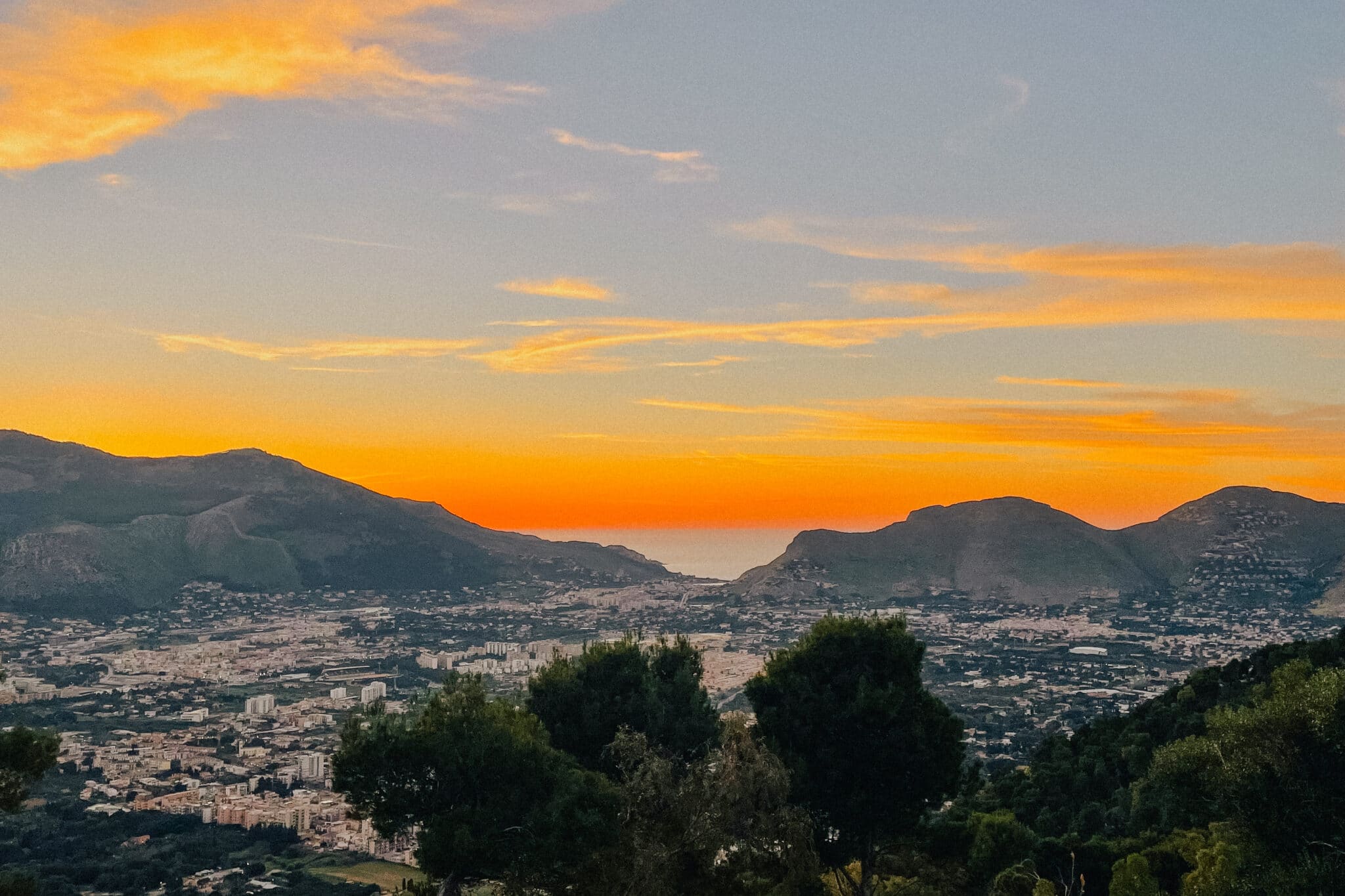
Mount Pellegrino rises up on the northern edge of Palermo and is impossible to miss — it’s dramatic, steep, and totally stunning, especially at golden hour. At the top you’ll find sweeping views over the city and coastline, plus a few historical landmarks like the Sanctuary of Saint Rosalia, Palermo’s patron saint.
Let me be clear: I did not hike this. You lowkey couldn’t pay me to hike this. The trails are long, steep, and, depending on the route, can take anywhere from three to six hours. If that sounds like your thing, go for it (and bring water). But for most people, I’d recommend the far easier route: drive up.

If you’ve rented a car or are up for a taxi ride, you can reach the top in about 15–20 minutes from the city center. We timed it for sunset and were rewarded with panoramic views that absolutely lived up to the hype — and froze our butts off, because it was late March and the wind was wild. Dress accordingly.
In summer, just know the road can get backed up around sunset. Plan to go a bit earlier, or brace yourself for a very slow scenic route.
12. Descend into Palermo’s Capuchin Catacombs (If You Dare)

So in full transparency, I did not visit the Capuchin Catacombs. I do not like dark, scary, death-related things (sue me!). But I’m including it here because I know many of you do love that kind of thing — and from all accounts, this place is intense, fascinating, and unlike anything else in Palermo.
Located just outside the main tourist zone, the Capuchin Catacombs are home to thousands of mummified bodies — many dressed in their original clothing, some positioned upright, and all arranged with a kind of eerie reverence. Families used to visit and even change their relatives’ outfits over time.
If you’re into the macabre, religious history, or just want a truly unique Palermo experience, this might be right up your alley. Entry is around €3, and photography is not allowed (respect that — it’s a burial site, not a photo op).
Go with curiosity, and maybe a strong stomach.
13. Take a Day Trip to the Ancient Temple of Segesta

If you’re craving a bit of classical drama and have a half-day to spare, the Temple of Segesta makes for an excellent escape from the city. It’s located about an hour outside of Palermo and offers one of the most impressive — and best-preserved — examples of Doric architecture in Sicily.
There are two main sights here: the 5th-century BC temple, standing in near-perfect condition despite never being finished, and a Greek theater carved into the hillside with panoramic views of the surrounding valley. If you’re into ancient ruins but don’t want to commit to a full day at Agrigento, this is a perfect alternative.

Insider Tip
Go early in the morning or late in the afternoon for cooler temps and fewer crowds. The light will be better for your photos, too.
You can get to Segesta by rental car (we always use Discover Cars), or join a guided tour that includes transportation. We skipped Segesta because we had just done Agrigento (coming soon), but I’ve heard nothing but glowing reviews — especially from history buffs.

The Ultimate Guide to Driving in Italy: How to Rent a Car & Drive Stress Free (+ Essential EV Rental Tips)
The Ultimate Guide to Driving in Italy: How to Rent a Car & Drive Stress Free (+ Essential EV Rental Tips)

Where to Eat in Palermo
Palermo is obviously full of restaurants — but not all of them are worth your time (or precious stomach space). These are the spots I actually loved and would go back to, organized by time of day:
For Breakfast
Sicilian breakfast = coffee and a pastry (usually brioche or a cornetto – similar to a croissant). In the summer, Sicilians will almost always add granita! Light, quick, and (when done right) perfect.
- TECO tea room – Well-reviewed and early-opening. A good bet for variety beyond pastries.
- Antica Caffeteria Corona – Our daily go-to. Warm, local, and the pistachio croissants were unforgettable. The first morning we came here, they only had one pastry left that we split between us and the nice older woman who ran the place was super apologetic.
Later that day we passed her shop and she called out to us to tell us we better come back in the morning, so Daniel jokingly said “we’ll be back if you have pistachio croissants for us!” (he’s the only one who speaks Italian). Lo and behold, in the morning she pulled four pistachio croissants out from behind the counter that she saved for us. Needless to say she reeled us in and we didn’t try anything else for breakfast for the rest of the trip. I miss her.
- OJDA – Cardamom buns, “real” coffee options (hello flat white), and a cozy, modern space.

For Lunch & Dinner
These spots delivered on flavor and atmosphere:
- BIGA Genio e Farina – Ideal for a fast, delicious pizza break when you’re on the move.
- Bisso Bistrot – Inside an old bookshop, right in the center, but still somehow low-key and legit.
- Osteria Alivàru da Carlo Napoli – In a quiet Kalsa piazza with a thoughtful, seasonal menu. A must-reserve.
- Ristorante La Galleria – Cozy and tucked away above the cathedral. Delicious food, shockingly affordable.
For Everything Else
Sweet treats and pre-dinner sips — Palermo does both very well:
- Ruvolo Caffetteria – Cannoli-only zone. Don’t bother with anything else on the menu.
- Dolce Capo – My favorite gelato. Worth the chaos (but maybe not on a Saturday night).
- Farmacia Alcolica – A bar with personality and great drinks. Perfect for people-watching in Kalsa.
- Ballarak Magione – Local brewery with a big patio and great craft beer — a fun switch from spritzes.
Want All My Picks in One Place? Get the Palermo Google Map!
I’ve pinned every restaurant, market, boutique, and hidden gem mentioned in this post — plus extras I didn’t have room for. You can load it right into your Google Maps app so you’re never unsure where to eat or what’s nearby while wandering Palermo IRL.
👉 Click here to get the map and start exploring like a local.

The Best Things to Do in Taormina: The Ultimate 4-Part Guide
Why Visit Sicily? 12 Spectacular Reasons To Go

Where to Stay in Palermo
As Sicily’s largest city, of course Palermo has endless options for where to stay, both within and just outside the historic center, that will put you right on the doorstep of all the best things to do in Palermo.
You can also check out my comprehensive hand-picked list of my favorite options for where to stay in Palermo, but here’s a small selection of amazing options I recommend (and almost stayed at myself!):
€€€ | 4 Star | Sophisticated Retreat | Central Location
Located just off of Via Vittorio Emmanuele, the chic Palazzo Natoli Boutique Hotel is an oasis of calm just steps away from all of the most important things to do in Palermo. With decor that perfectly compliments the historic building the hotel occupies, the hotel offers balconies in most of its rooms where you’ll be able to have your morning cappuccino in style, just like the Italians do… sipping away as you nosily people watch the passersby below! Recent guests rave about the welcoming staff, cleanliness, and personal touches.
CHECK RATES & AVAILABILITY FOR YOUR DATES
Photo: Booking.com
€€ | 4 Star | Impeccable Design | Small-Scale Luxury
Just a few steps from Quattro Canti and Ballarò market, you’ll find Sui Tetti di Balarm, a tiny independent hotel featuring just 4 rooms—meaning it books up quickly! Two of the four feature private terraces with outdoor tubs, overlooking the gorgeous dome of Chiesa del Gesù. There are also three shared spaces available to all guests: a living room, kitchen, and communal terrace. If you’re into B&B vibes with a luxury twist, this hotel is a must-stay.
CHECK RATES & AVAILABILITY FOR YOUR DATES
Photo: Booking.com
€ | 4 Star | Happening Surroundings | Spacious Rooms
These rooms are more like mini studios located just off the main drag of Vucciria market in Castellammare. Garnering a surprising 5.0 on Google and 9.7 on Booking.com at the time of writing, Sant’Andrea Luxury Rooms is the perfect option for anyone who enjoys a slightly more industrial design vibe or wants a bit more space to spread out.
CHECK RATES & AVAILABILITY FOR YOUR DATES
Photo: Booking.com
FAQs about Things to do in Palermo
Is Palermo Sicily worth visiting?
Yes—Palermo is loud, chaotic, and a little rough around the edges… but that’s what makes it great. It’s a city full of history, street food, late nights, and real character. If you love places that feel lived-in and a little unpredictable, Palermo is 100% worth your time.
Palermo is the capital of Sicily, and the fifth largest city in Italy overall (Catania, Sicily’s second city, is only the tenth largest in Italy, just to offer some scale), so it’s a pretty important stop on any trip to Sicily. I think anyone who is able to visit Palermo should jump at the opportunity, and plan the time you’re there based on your wants and needs.
Palermo is perfect as a city break, or as a stop on a wider Sicily trip to break up the small towns and beach vibes. Stopping in Palermo offers you a chance to see all the different dominations Sicily has experienced through over the years, from Greeks and Romans, to the Arabs and Normans, and finally the French and Spanish.
It also has some of the most famous markets in Sicily, and is the best place to learn about the current and past influences of the Mafia in Sicily.
There are even beaches and beach towns nearby to Palermo, so there really is something for everyone.

How many days do you need in Palermo?
3-4 days is an ideal amount of time for most people budget for all the main things to do in Palermo. I’m pretty biased, so I actually would say that five days is my personal preference if I were to go back. As a proponent of slow travel, I really feel like the best way to get a feel for any new place—but especially a city—is by simply being in it.
You can get all the main sights done in more or less two days, including doing a walking tour or two. Then you have one day to head to the beach if the weather permits, and another day to just soak up the energy of Palermo, wandering aimlessly and sitting at cafes to your heart’s content. If you had an extra day, or were doing this as part of a larger Sicily trip, you could then do a day trip to a nearby town as part of your itinerary.
Is Palermo walkable?
Yes, Palermo is definitely a walkable city. In terms of square miles, Palermo is a pretty large city, larger than cities like Paris and San Francisco, but the bulk of things to do in Palermo are concentrated to the old city, which is much smaller and super easily seen on foot.
Like many Italian/European cities, you’ll come across a lot of cobblestones and a lot of uneven ground, so I would definitely keep note of that if you or anyone you’re traveling with has mobility issues or cannot walk for long periods of time! If you’re worried at all about having to walk too much in Palermo, don’t worry—there are tons of taxis around the center, and there are apes everywhere too, which are basically Italy’s version of a tuktuk.

What is Palermo best known for?
Palermo is best known as being the largest city in Sicily, as well as the capital city. It showcases so much of Sicily’s history through the different styles of architecture and landmarks throughout the city, where you’ll see Arab, Norman and Spanish influence. Palermo is widely known for its famous street food too, with arancine, sfincione and panelle being the main attractions.
Palermo is also well known as being the main center for mafia violence in the years when they were most active, as well as the center of the anti-mafia movement in Sicily today. It’s also one of the most visited destinations on the island (though it doesn’t get the top spot—that’s reserved for Taormina).
What to do in Palermo in 3 days?
If you only have three days there are tons of things to do in Palermo to fill your time.
On the first day I recommend doing a walking tour to get a good feel for the city and knock off a portion of the main sights. Bonus points if it also has a food component, because Palermo is well known for its street food. This is the tour we did, and we thought it was a great primer to better understand just how much history Palermo has seen!
I also highly recommend doing the popular anti-mafia tour while you’re there (highly rated and run by the official grassroots organization who really got the anti-mafia movement off the ground in the early 2000s)—but maybe save that for the second day so as to not overwhelm!
One of the best things to do in Palermo is to just spend some time just wandering around the different markets and neighborhoods to soak up all the energy that Palermo has to offer, and make sure to pop into all the artisan shops you see along the way. If the weather permits you should definitely make time to head to the beach—Mondello is the best option nearby to Palermo—and for a stunning golden hour/sunset you should head up to Monte Pellegrino.

Is Palermo an expensive city?
Now obviously this answer is relative, both to wherever you’re coming from and what you’re used to, and of course based on where else in Sicily you might be visiting. That being said, when we were in Palermo we didn’t find it to be expensive at all. The food, the attractions, the drinks, and even the accommodation were super fairly priced considering we were in the biggest city in Sicily.
For reference we were able to eat a meal for four at a super cute, delicious local restaurant (with starters, pasta, mains, dessert, and a bottle of wine) for under €200. Breakfast at a local caffeteria every morning cost less than €20 for the four of us.
Is Palermo safe for tourists?
Overall, yes. Like in any city, stay alert — especially at night or in quieter alleyways — but we never felt unsafe. Use common sense (zip your bag, avoid flashing valuables) and you’ll be fine. Palermo has a gritty reputation, but it’s mostly just lively and a bit wild — not dangerous.
Can I use Palermo as a base to explore Sicily?
You can, especially if you don’t want to move around too much. There are great day trips nearby — like Segesta, Cefalù, and Monreale — but keep in mind that western Sicily is less train-connected than the east, so you may need a rental car for full flexibility.

Is Catania or Palermo better?
This is so hard to give a straight answer to because I genuinely fell in love with both cities. I think both Catania and Palermo are absolutely worth visiting, and if you’re planning a larger trip they work equally well as a stop along the way, but if you’re looking for which city would win as a standalone city-break, then I have to give it to Palermo.
Palermo and Catania are both… so beautiful and special. They both feel equally accessible and inaccessible, exciting and overwhelming, but also so different and conflicting with one another. You just have to go and feel the energy yourself to be honest. I think that there are upsides and drawbacks to each city, reasons to rank one above the other that I could go between for days, but ultimately it’s a subjective topic!
There is no right answer and I’m sure that for as many people who think Palermo is better, you’ll find an equal amount who think it’s Catania.
I can say that I loved Catania so much that I wished we had more days there, and we stayed more than recommended. Then in Palermo I felt pretty overwhelmed, but left wondering if I could eventually end up moving there. So clearly they’ve both left an impression on me. Both cities are wonderful and you will have an incredible time in either, please don’t make me choose.
My best advice would be to weigh the cities equally, and then choose based on which side of the island they’re on. Whether that means you choose based on which airport makes more sense to fly into, or whether you want to explore baroque architecture (for which Catania is famous) or street food culture (more of a thing in Palermo)—let that guide you! I doubt you’ll be disappointed in either option.

Planning Cheat Sheet: Every Link You Need in One Place
P.S. When you book using my links, you help support Rachel IRL at no extra cost to you. It’s a win-win!

Ready to explore Palermo?
Palermo surprised me in all the best ways. I came in unsure, slightly skeptical, and fully braced for chaos — and somehow I left trying to figure out how to come back long-term.
This city isn’t for everyone. It’s noisy, occasionally scruffy, and doesn’t always present itself neatly. But if you give it a little time (and a lot of snacks), Palermo will absolutely charm you — with its golden light, its tangled neighborhoods, and its endless contradictions.
I hope this guide helps you fall for it a little faster than I did.
And if you want to take all my recs on the go — from gelato to viewpoints to vintage shops — don’t forget to download my Palermo Google Map. It’s the easiest way to explore without missing a hidden gem.
Downloadable
Google Maps
Save time and explore like a local with my curated Google Maps. Get all my best recommendations, hidden gems, and tips in one easy-to-use guide—no note-taking required!

Liked this post? Pin it for later!
